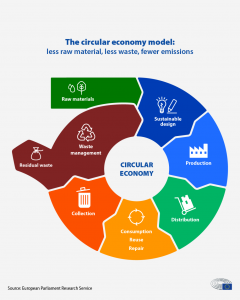Life After Waste: Closing the Loop of the Circular Economy
How our clients are contributing to the circular economy in the UK.
The circular economy is a hot topic in the realm of sustainability. Many of the clients that we work with are involved in some way with furthering the development of the circular economy in fascinating and innovative ways.
What do we mean by the Circular Economy?
The circular economy is a model for reducing waste to a minimum. It involves sharing, leasing, reusing, repairing, refurbishing and recycling existing materials and products for as long as possible. In this way the lifecycle of products can be prolonged.
At a household level, taking clothing as an example, this can mean selling or donating old items instead of sending them to landfill, learning to repair worn or torn fabric to prolong the life of a garment, or leasing clothing for a special occasion which you may only wear once.
At an industrial level, there are many methods for contributing to waste reduction, including improved recycling sorting methods, reuse of waste products from manufacturing processes, or increasing efficiency of processes to minimise waste products altogether.

Hazardous Materials – new fuel sources on the rise
Strict rules govern the handling and disposable of waste deemed hazardous, which can include asbestos, chemicals such as brake fluid, and spent fuel from various sources such as the maritime and aviation industries. Being able to refine, reuse and ultimately recycle this waste reduces the burden on our ecosystem and can streamline processes.
For example, one of our clients produces a range of sustainable waste-derived fuels from recovered sources that can’t be recycled back into their original state. These include biomass, oil, refuse-derived fuel (RDF) and solid recovered fuel (SRF).
Waste oil can be tested, treated and processed at licenced facilities. Specialist waste processors can produce used lubricating oil (ULO) for re-refining back into base lubricants, supporting the circular economy.
They also produce processed fuel oil (PFO) for use as a high-quality fuel in the asphalt industry, industrial driers, power stations, large boilers and furnaces and as a low-sulphur alternative for bunkering oil in ships.
Construction and demolition – reusing waste materials
Reusing construction waste can save huge amounts of energy and reduce costs on site. Although 61% of all UK waste is produced by the construction sector, it also has a 91% recovery rate. This means that waste can often be repurposed with little effect to the quality of the end product.
For example,
- Concrete can be recycled for use in roads, pavements and aggregate for new concrete
- Brick/masonry can be used as aggregate for gravel, broken down to make smaller bricks, or made into sand
- Metal can make a variety of new metal items (metal is 100% recyclable)
- Glass, similar to metal, is 100% recyclable and can be used to make sand, gravel, and new building materials
- Wood can be chipped to make landscaping mulch, bedding, fuel, composite board products and pallets
Source: Biffa
General Waste and Energy from Waste – minimising residual waste products
Municipal solid waste (MSW) is often taken to an Energy Recovery Facility where the waste is incinerated in order to produce energy to power our homes. This process leaves behind a residue which is known as IBA which includes metals and other non-flammable materials.
The metals from IBA can be extracted and recycled back into the metal manufacturing industry (see above that metal is 100% recyclable). The rest of the bottom ash could end up in landfill, but is able to be processed into aggregate and used in civil construction works as a replacement for primary materials.
This IBAA (incinerator bottom ash aggregate) is an extremely cost-effective material when compared to Primary Aggregates. There are also logistical advantages when using IBAA due to the low density of the material, it allows for fewer vehicle movements because there are volumetric advantages over primary material.
Innovation – working together to further end goals
“About half the reductions to get to net zero emissions in 2050 will need to come from technologies that are not yet ready for market. This calls for massive leaps in innovation.”
Fatih Birol ED, International Energy Agency (IEA)
Ambitious targets from both governments and industry will require the Waste Management industry to continue to collaborate and innovate to stay on track.
Upcoming initiatives such as the deposit return scheme and mandatory food waste collection across the UK will require manufacturers, the waste management industry and local authorities to work closely in order to provide a seamless service for consumers.
AI is becoming ubiquitous in conversations around innovation, and it’s no different in the Waste Management space. AI and machine learning technologies are increasingly being utilised in the waste sorting process. Algorithms are being trained to be able to classify waste so that sorting plant operators can better see which materials are going in and out.
Global examples of innovation can also serve as a roadmap for the industry in the UK. Singapore’s Tuas Nexus project will involve an integrated waste management facility processing incinerable waste, household recyclables and source-segregated food waste, with a water reclamation plant, which will treat used water.
The project is designed on circular economy principles, using the co-digestion of food waste with used water sludge to increase the yield of biogas production. This biogas will be used to increase the plant’s thermal efficiency and power generation to enable it to be self-sufficient, and it will also export more power to the electricity grid.
Playing a role in the circular economy
If you’re interested in playing a part in the circular economy of the future, check out our open vacancies or send us your CV.




